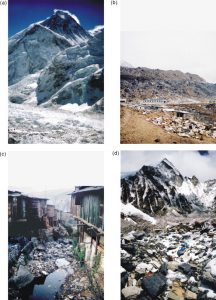Landscapes have become a major concept in archaeology. More often than not, archaeologists must study today’s landscapes to fully understand how they were used in the past. Archaeologists focus on landscapes, for “a landscape perspective can be used to address the built environment of cities, the physical layout of hinterlands, and the ways in which these distinctly shaped spaces would have been experienced by their inhabitants” (Smith, 2014). Landscapes are very important, for they hold valuable details of the people who once occupied the land.

Stone Chamber in Kent, New York (http://www.ancientpages.com/2015/10/11/mysterious-ancient-stone-chambers-and-unexplained-energy-force-in-the-ninham-mountain-putnam-county/)
As archaeologists study these landscapes, they find a wide variety of artifacts, and features, depending on the region they are in. For instance, if an archeologist were to explore upstate New York, such as Kent, they would be expected to find various stone chambers. These chambers could lead an archaeologist to believe these features were once used to store objects, such as grain perhaps. However, one cannot simply infer this, and be sure they are correct. Therefore, it is important archeologists study the entirety of a landscape in order to find other objects that support their ideas.
Unfortunately, archeologists do not just find artifacts from the past on these landscapes. More often than not, archaeologists encounter trash from those living today. This dumping of trash is very dangerous, for it is the beginning of a vicious cycle that depreciates the value of land immensely. In locations where there are loads of trash, most people tend to infer this land as flawed, or invaluable. For instance, a study was done by Beau Breza in the article, The aesthetic value of a mountain landscape: A study of the Mt. Everest Trek, to see what people viewed as valuable lands, versus displeasing. Participants were shown a variety of mountain landscapes and were told to rank them in an order which they found most aesthetically pleasing. After conducting the survey, it was clear the participants viewed the landscapes with more garbage as less valuable, despite the beauty underneath it (Beza, 2010). This is unfortunate, for in reality the value of land is based on what it could provide a population with, not the disrespect that has accumulated on its surface. However, once there is a noticeable amount of trash on a landscape, many people begin to believe it is acceptable to continue to trash these lands because they have already been deemed worthless. This is dangerous to archaeology, for trash hinders what details archeologists are able to uncover about the populations that previously inhabited these lands. Once a group disrupts a landscape, the untold stories of that land can almost never be retrieved. Thus, it is important to keep landscapes clean, otherwise, the information they hold may never be found.
Landscapes have a large impact on the details archaeologists uncover about the people of the past. It is important society keeps this in mind, for there are many questions still left unanswered. These answers will never be found if trash continues to accumulate on Earth’s landscapes.
Additional Content
This study was done to show how local preferences have a large effect on what landscapes are chosen for better future management and explains what characteristics of landscapes are ideal.
https://www.sciencedirect.com/science/article/pii/S0169204607002241
This study was done to discuss the pressures of urban planning in rural areas, emphasizing the need to keep the natural landscapes.
https://www.sciencedirect.com/science/article/pii/S0169204610002148
References
Beza, B. B. (2010, August 16). The aesthetic value of a mountain landscape: A study of the Mt. Everest Trek. Retrieved September 30, 2018, from https://www.sciencedirect.com/science/article/pii/S0169204610001490#!
Smith, M. L. (2014). The Archaeology of Urban Landscapes. Annual Review of Anthropology,43, 307-323. doi:10.1146/annurev-anthro-102313-025839
Image Sources
Mysterious Ancient Stone Chambers And Unexplained Energy Force In The Ninham Mountain, Putnam County. (2017, December 12). Retrieved from http://www.ancientpages.com/2015/10/11/mysterious-ancient-stone-chambers-and-unexplained-energy-force-in-the-ninham-mountain-putnam-county/
Beza, B. B. (2010, August 16). The aesthetic value of a mountain landscape: A study of the Mt. Everest Trek. Retrieved September 30, 2018, from https://www.sciencedirect.com/science/article/pii/S0169204610001490#!


I would push back on some of what you have to say about trash and archaeology. Most of archaeology is, in fact, trash! You say that people dumping “. . . is dangerous to archaeology, for trash hinders what details archeologists are able to uncover about the populations that previously inhabited these lands.” But does it not also show how people think about certain landscapes, what is valuable and what is not? Is dumping a political statement of those who are doing it? What can we learn for garbage? (Look up garbology!)
I agree, the dumping of trash most definitely demonstrates the opinions people may have in regards to the value of a landscape. For instance, land with more litter may be viewed as less valuable. After researching garbology, I learned garbage can be a large part of political protest. For example, if state-owned lands are full of litter it can be inferred that those of whom are littering have little, to no respect for the state.
References:
Humes, E. (2013). Garbology: Our dirty love affair with trash. New York: Avery, a member of Penguin Group (USA).